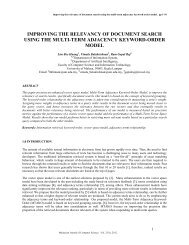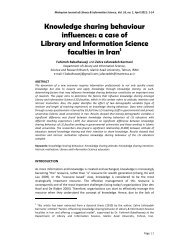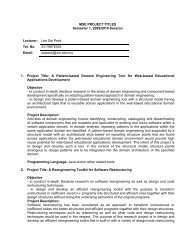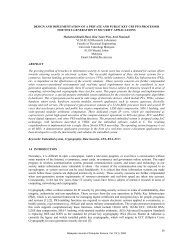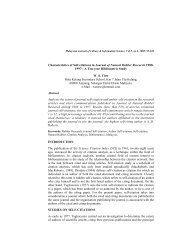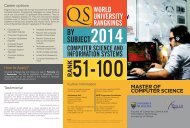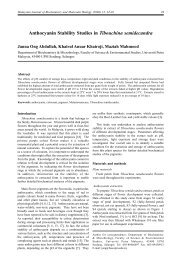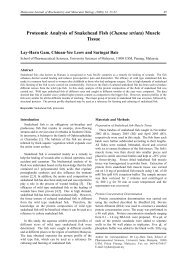Download1 - EJUM
Download1 - EJUM
Download1 - EJUM
Create successful ePaper yourself
Turn your PDF publications into a flip-book with our unique Google optimized e-Paper software.
Effective Algorithm for Optimal K-Terminal Reliability of Distributed SystemIn Step 1, after evaluating each node’s weight using Eq. (1), v 5 is the heaviestnode and is served as starting node for obtaining an adequate K-terminal. Notethat G k is {v 5 }.In Step 2, after finding ε s, j, we have E ={ ε ε( Gk ) 5, 2}.In Step 3, each link’s weight is evaluated using Eq. (2) and each ε s, jin Eε( Gk )is evaluated using Eq. (3)In Step 4, let V tmp = V = {v ε( Gk ) 2}, w( V Gk) = w(v s ), w( E Gk) = 0.In Step 5, for sets of nodes, V adj(Gk) = {v 3 , v 4 , v 6 } and V tmp = {v 2 }, find v i , in(V adj(Gk) Υ V tmp ). Using Eq. (5) to compute the weight, we have w({v 5 , v 3 }) =1.079026, w({v 5 , v 4 }) = 0.1.146226, w({v 5 , v 6 }) = 1.131129 and w({v 5 , v 2 }) =1.093191. Because the weight of {v 5 , v 4 } is maximum, v 4 is appended to G k .Notably, G k is {v 5 , v 4 }.In Step 6, the reliability of the K-terminal {v 5 , v 4 } is computed using SYREL.We have R({v 5 , v 4 }) = 0.9452258 which has the maximum reliability underK request . The number of reliability computation is exactly one.The result is the same as in the K-terminal, which is derived by an exhaustivemethod.COMPARISON AND DISCUSSIONResults obtained from our algorithm were compared with those of exhaustivemethod and random method. Although capable of yielding the optimal solution,conventional techniques such as exhaustive method cannot effectively reduce thereliability count. An application occasionally requires an efficient algorithm tocompute reliability owing to resource considerations. Under this circumstance,deriving the optimal reliability may not be feasible. Instead, an efficient algorithmyielding approximate reliability is preferred.In contrast to the computer reliability problem, which is static-oriented, the KTRproblems in the DS are dynamic-oriented since many factors, e.g. DS topology, linkreliability, and the number of paths between each node, can significantly affect theefficiency of the algorithm(Aziz, 1997; Nakazawa, 1981; Makri and Psillakis,1997). Next, the accuracy and efficiency of the proposed algorithm are verified byimplementing simulation programs C language that are executed on a Pentium 133with 16M-DRAM on MS-Windows 95. We use many network topologies andgenerated several hundreds of data for simulation. The reliability of each link wasgenerated using a random number generator. For verifying the sensitivity of ourproposed algorithm, two data categories were given in different ranges. For the linkreliability, we considered the following range: 0.0~1.0, 0.5~1.0 and 0.8~1.0. For111



